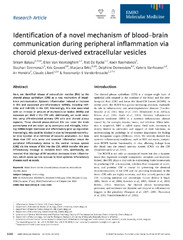Приказ основних података о документу
Identification of a novel mechanism of blood–brain communication during peripheral inflammation via choroid plexus‐derived extracellular vesicles
| dc.creator | Balusu, Sriram | |
| dc.creator | Van Wonterghem, Elien | |
| dc.creator | De Rycke, Riet | |
| dc.creator | Raemdonck, Koen | |
| dc.creator | Stremersch, Stephan | |
| dc.creator | Gevaert, Kris | |
| dc.creator | Brkić, Marjana | |
| dc.creator | Demeestere, Delphine | |
| dc.creator | Vanhooren, Valerie | |
| dc.creator | Hendrix, An | |
| dc.creator | Libert, Claude | |
| dc.creator | Vandenbroucke, Roosmarijn E. | |
| dc.date.accessioned | 2016-11-28T12:51:43Z | |
| dc.date.available | 2016-11-28T12:51:43Z | |
| dc.date.issued | 2016 | |
| dc.identifier.issn | 1757-4676 | |
| dc.identifier.uri | http://embomolmed.embopress.org/lookup/doi/10.15252/emmm.201606271 | |
| dc.identifier.uri | https://www.scopus.com/record/display.uri?eid=2-s2.0-84989915450&origin=SingleRecordEmailAlert&txGid=66B9A38F509F4540CF41E07DD21FB6C0.wsnAw8kcdt7IPYLO0V48gA:27# | |
| dc.identifier.uri | https://radar.ibiss.bg.ac.rs/handle/123456789/2471 | |
| dc.description.abstract | Here, we identified release of extracellular vesicles (EVs) by the choroid plexus epithelium (CPE) as a new mechanism of blood–brain communication. Systemic inflammation induced an increase in EVs and associated pro-inflammatory miRNAs, including miR-146a and miR-155, in the CSF. Interestingly, this was associated with an increase in amount of multivesicular bodies (MVBs) and exosomes per MVB in the CPE cells. Additionally, we could mimic this using LPS-stimulated primary CPE cells and choroid plexus explants. These choroid plexus-derived EVs can enter the brain parenchyma and are taken up by astrocytes and microglia, inducing miRNA target repression and inflammatory gene up-regulation. Interestingly, this could be blocked in vivo by intracerebroventricular (icv) injection of an inhibitor of exosome production. Our data show that CPE cells sense and transmit information about the peripheral inflammatory status to the central nervous system (CNS) via the release of EVs into the CSF, which transfer this pro-inflammatory message to recipient brain cells. Additionally, we revealed that blockage of EV secretion decreases brain inflammation, which opens up new avenues to treat systemic inflammatory diseases such as sepsis. | en |
| dc.publisher | Blackwell Publishing Ltd | |
| dc.rights | openAccess | |
| dc.rights.uri | https://creativecommons.org/licenses/by/4.0/ | |
| dc.source | EMBO Molecular Medicine | |
| dc.subject | blood–brain barrier | |
| dc.subject | choroid plexus | |
| dc.subject | exosomes | |
| dc.subject | extracellular vesicles | |
| dc.subject | sepsis | |
| dc.title | Identification of a novel mechanism of blood–brain communication during peripheral inflammation via choroid plexus‐derived extracellular vesicles | en |
| dc.type | article | |
| dc.rights.license | BY | |
| dcterms.abstract | Хендриx, Aн; Либерт, Цлауде; Балусу, Срирам; Ван Wонтергхем, Елиен; Де Рyцке, Риет; Раемдонцк, Коен; Стремерсцх, Степхан; Ванденброуцке, Роосмаријн Е.; Бркиц, Марјана; Демеестере, Делпхине; Ванхоорен, Валерие; Геваерт, Крис; | |
| dc.rights.holder | © 2016 The Authors. | |
| dc.citation.issue | 10 | |
| dc.citation.volume | 8 | |
| dc.identifier.doi | 10.15252/emmm.201606271 | |
| dc.identifier.pmid | 27596437 | |
| dc.identifier.scopus | 2-s2.0-84989915450 | |
| dc.identifier.wos | 000387111700007 | |
| dc.citation.spage | 1162 | |
| dc.citation.epage | 1183 | |
| dc.type.version | publishedVersion | en |
| dc.identifier.fulltext | https://radar.ibiss.bg.ac.rs/bitstream/id/5700/Balusu_et_al-2016-EMBO_Molecular_Medicine.pdf | |
| dc.citation.rank | M21 |

